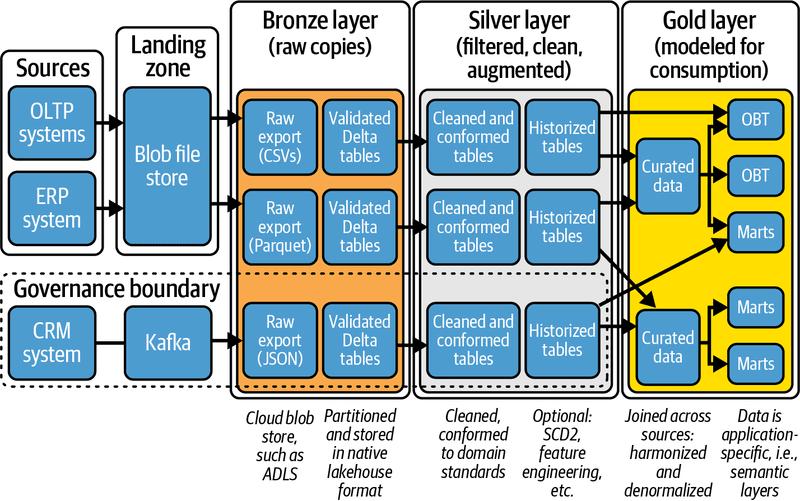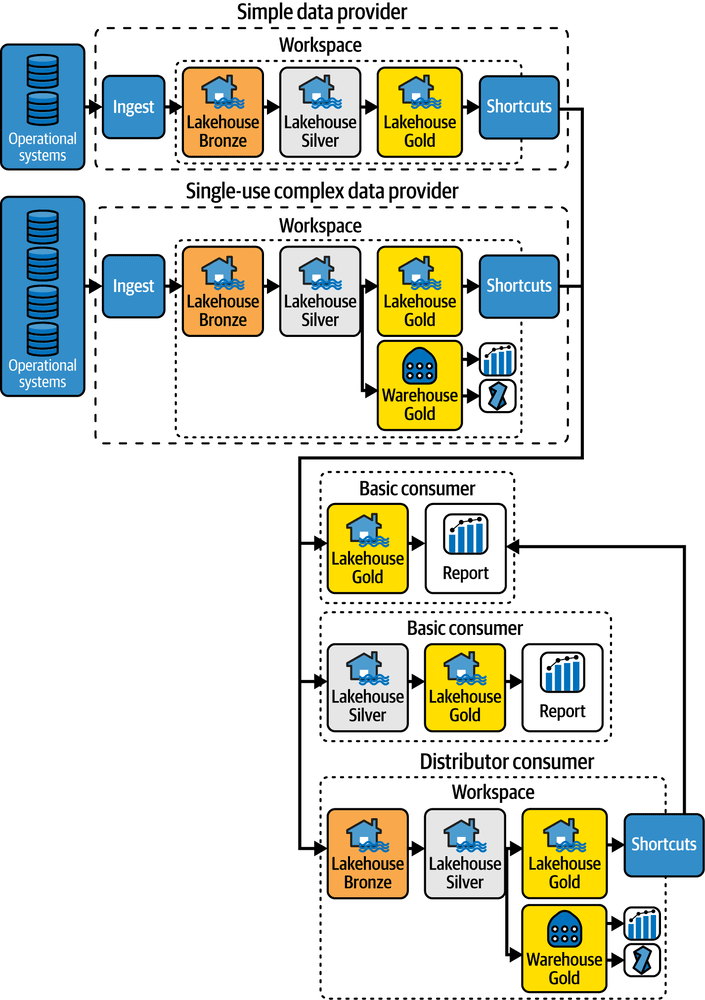Rethinking the Medallion Architecture for Modern Data Platforms
Piethein Strengholt
August 12, 2025

The Medallion architecture is a popular design pattern for organizing data within a Lakehouse architecture. Many large enterprises use this pattern to logically structure their data.
In this post, I’ll outline how the architecture works, explore its adaptability in modern enterprise environments, and highlight why it remains relevant, especially as data teams scale and federate.
Understanding the Three Layers
Bronze Layer
This layer acts as the zone for raw data collected from various sources. Data in the Bronze layer is stored in its original structure without any transformation, serving as a historical record and a single source of truth. It ensures that data is reliably captured and stored, making it available for further processing. Its key characteristics include high volume, variety, and veracity. The data is immutable to maintain the integrity of its original state.
Silver Layer
This layer refines, cleanses, and standardizes the raw data, preparing it for more complex operational and analytical tasks. In this layer, data undergoes quality checks, standardization, deduplication, and other enhancements that improve its reliability and usability. The Silver layer acts as a transitional stage where data is still granular but has been processed to ensure quality and consistency. Its key characteristics are that data in the Silver layer is more structured and query-friendly, making it easier for analysts and data scientists to work with.
Gold Layer
This layer delivers refined data optimized for specific business insights and decision-making. The Gold layer involves aggregating, summarizing, and enriching data to support high-level reporting and analytics. This layer focuses on performance, usability, and scalability, providing fast access to key metrics and insights.
Why the Layers are Logical, Not Physical
It’s crucial to think of these layers as logical, not physical. So, when discussing, for example, the Bronze layer, don’t frame it as just one physical layer. Instead, view it as a logical layer that could span across several physical layers. Below is how the Medallion architecture could look in practice:

Figure 1 – Building Medallion Architectures, O’Reilly (2025)
This conceptual flexibility is vital, particularly in larger organizations. As these organizations expand, they face the challenge of scaling data management to support increased data volumes, accommodate more users, and address a wider variety of use cases.
Federated Medallion Architecture
In this context, it is important to understand that the Medallion architecture should not be viewed as a rigid concept; rather, it represents a spectrum of possibilities that can be adapted to unique circumstances, including the option of having multiple Medallion architectures tailored to different needs, which can influence the design of the overall architecture.
For instance, consider managing two Medallion architectures—one tailored to the source system and the other to consumption. In this case, the interaction between layers becomes crucial. You could argue that the Gold or data product layer in the source-aligned architecture effectively acts as the Bronze layer in the consumption-aligned architecture. This approach creates a more streamlined architecture by eliminating the need to duplicate the data product layer in the Bronze layer of the consumption setup.
The image below illustrates an architectural style that employs two basic consumers: a simple data provider, a single-use complex provider, and a distributor consumer.

Figure 2 – Building Medallion Architectures, O’Reilly (2025)
Managing Complexity Across Teams
Building Medallion architectures can be challenging, especially when many teams are involved, each requiring access to data from others. In such scenarios, you might consider establishing separate Medallion architectures for each team, complete with their own Bronze, Silver, and Gold layers.
However, offering good guidance is essential to prevent the emergence of too many variations, which could hinder interoperability between domains and create silos that complicate data sharing and collaboration.
In conclusion, the Medallion model is not a one-size-fits-all solution. However, it remains one of the most practical and adaptable design patterns for structuring AI-ready, analytics-grade data pipelines—especially in complex, federated, and continually growing environments.
To explore the concepts in more depth, check out my book:
Building Medallion Architectures: Designing With Delta Lake and Spark (O’Reilly, 2025)
Or watch the full replay of the webinar:
The Big Medallion Architecture Debate
With Ole Olesen Bagneux, Actian Chief Evangelist
Subscribe to the Actian Blog
Subscribe to Actian’s blog to get data insights delivered right to you.
- Stay in the know – Get the latest in data analytics pushed directly to your inbox.
- Never miss a post – You’ll receive automatic email updates to let you know when new posts are live.
- It’s all up to you – Change your delivery preferences to suit your needs.
Subscribe
(i.e. sales@..., support@...)





